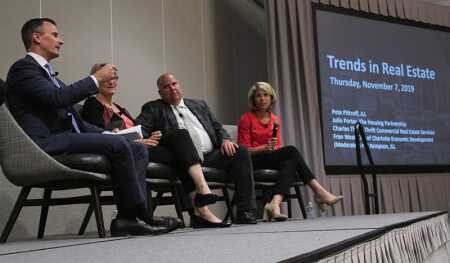With a series of recent high-profileeconomic development wins, Charlotte, North Carolina, has affirmed its statusas a market to watch for real estate investors.
Placing fourth in the rankings for best overall real estate prospects in Emerging Trends in Real Estate® 2020, copublished by ULI and PwC, the Queen City recently landed the corporate headquarters of Honeywell International, as well as Truist, the bank that will result from the merger of BB&T and SunTrust. The city also benefited from in-market expansions, including a 2,000-employee tech center announced by home improvement retailer Lowe’s and a 400-job expansion announced by Microsoft.
Panelists at a recent ULICharlotte event acknowledged that the city has much to be thankful for as itheads into 2020, but they also noted the need to protect Charlotte’s quality oflife and relative affordability, which have been key to attracting economicdevelopment and outside investment.
“[Affordability] is one of thethings that drives these companies to come to Charlotte,” said Julie Porter, presidentof the Charlotte-Mecklenburg Housing Partnership, a nonprofit development firmfocused on housing for low- and moderate-income families. “We need to keepthat.”
Because the city’s housingstarts aren’t keeping up with its population growth, Charlotte’s housing marketis “incredibly strong,” Porter said, but the lack of inventory is pushing pricesever higher; Charlotte ranked second for homebuilding prospects in Emerging Trends. At the end of October, theregion had a two-month supply of housing inventory, according to the CharlotteRegional Realtor Association, down 25 percent from a year earlier, and themedian sales price had increased by nearly 10 percent to $253,000. Five to sixmonths of housing inventory is generally considered a balanced market.
“There’s a shortage of housingacross the spectrum,” Porter said. “We’re still about 34,000 units short ofaffordable housing for people who earn less than 50 percent of AMI [area medianincome]. We see those types of shortages continuing.”
The announcement by Lowe’s thatit would anchor a new 23-story office tower just outside Charlotte’s centralbusiness district in the South End neighborhood underlined the city’s emergenceas a destination for technology companies and their employees. Last fall,CompTIA’s 2018 Tech Town Index found that Charlotte was the number-one city forinformation technology workers, on the basis of job opportunities and cost ofliving.
“I think in 2020, with ourgrowth in tech talent, we’re really going to see a lot of these small techcompanies with rapid growth plans,” said Fran West, who leads businessrecruitment efforts for the city of Charlotte.
The city needs to continuerecruiting tech employees because the demand for talent outstrips what localuniversities like the University of North Carolina–Charlotte can currently produce,she added.
“How do we do that? By keepingour quality of life really high and our cost of living really low,” she said. “Wehave to make strategic investments in our infrastructure, our housing, and inthe places that talent wants to be because companies are going to chasetalent.”
The Charlotte market was rankedthird for investment in the industrial sector in this year’s Emerging Trends, with 61 percent ofrespondents rating it a buy, behind only Austin, Texas, and Washington,D.C./Northern Virginia. Pete Pittroff, a managing director with JLL, said heexpects industrial vacancy in the region to approach 5 percent by the end of thisyear, with rental rate growth up by more than 5 percent on a year-over-yearbasis.
Though Pittroff said he expectsanother good year in 2020, he expressed concern about the trajectory ofconstruction costs.
“What happens if constructioncosts continue to rise and rental rate growth stops?” he asked. “To me, thatcollision looks a little uncomfortable.”
Rising costs are affectingproperty owners across all sectors. While Charlotte’s rental rates for retailspace remain relatively affordable compared with those in other markets, landprices are putting pressure on landlords to raise those numbers, said CharlesThrift, partner of Charlotte-based Thrift Commercial Real Estate. As a result, propertyowners are having to bring in tenants from outside Charlotte that are moreaccustomed to higher rents, he said.
“There’s complaints I hearabout driving out the local businessperson,” Thrift said. “It is harder to findthe local operator that’s going to be willing to step up and pay those rents.”
These challenges are still thebyproduct of a healthy local economy, however, and Pittroff said he remindedhimself of that when it took him an hour to navigate nine miles (14.5 km) oftraffic to his home recently.
“I was riding along thinking, ‘This is awesome,’” he said. “It just means that we’re growing.”
WILL BOYE is a senior public relations executive with Yellow Duck Marketing.





